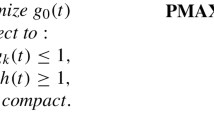Abstract
This work is concerned with generalized convex programming problems, where the objective function and also the constraints belong to a certain class of convex functions. It examines the relationship of two basic conditions used in interior-point methods for generalized convex programming—self-concordance and a relative Lipschitz condition—and gives a short and simple complexity analysis of an interior-point method for generalized convex programming. In generalizing ellipsoidal approximations for the feasible set, it also allows a geometrical interpretation of the analysis.
Similar content being viewed by others
References
M. Groetschel, L. Lovasz, S. Schrijver, Geometric Algorithms and Combinatorial Optimization, Springer-Verlag, Heidelberg, 1988.
D. den Hertog, C. Roos, T. Terlaky, On the classical logarithmic barrier function method for a class of smooth convex-programming problems, Report 90-28, Delft University of Technology, 1990.
F. Jarre, The method of analytic centers for solving smooth convex programs, in Optimization (S. Dolecki, ed.), Lecture Notes in Mathematics, Vol. 1405, Springer-Verlag, Berlin, 1989, pp. 69–85.
F. Jarre, On the convergence of the method of analytic centers when applied to convex quadratic programs, Mathematical Programming, 49 (1991), 341–358.
F. Jarre, The Method of Analytic Centers for Smooth Convex Programs, Grottenthaler-Verlag, Bamberg, 1989.
F. Jarre, G. Sonnevend, J. Stoer, An implementation of the method of analytic centers, in Analysis and Optimization of Systems (A. Bensoussan, J. L. Lions, eds), Lecture Notes in Control and Information Sciences, Vol. 111, Springer-Verlag, Berlin, 1988, pp. 297–307.
I. J. Lustig, R. E. Marsten, D. F. Shanno, On implementing Mehrotra's predictor corrector interior-point method for linear programming, Technical Report SOR 90-03, Dept. Civil Engineering and OR, Princeton University, Princeton, NJ, 1990.
S. Mehrotra, J. Sun, An interior-point algorithm for solving smooth convex programs based on Newton's method, Technical Report 88-08, Dept. Industrial Engineering and Management Sciences, Northwestern University, Evanston, IL, 1988.
S. Mehrotra, On the implementation of a (primal-dual) interior-point method, Technical Report 90-03, Dept. Industrial Engineering and Management Sciences, Northwestern University, Evanston, IL, 1990.
J. Mennicken, Implementation of a first order central path following algorithm for solving large linear programs, Report No. 202, Schwerpunktprogramm der DFG Anwendungsbezogen Optimierung und Steuerung, Institut für Amgewandte Mathematik und Statistik, Universität Würzburg, Am Hubland, 1990.
J. E. Nesterov, A. S. Nemirovsky, A general approach to polynomial-time algorithms design for convex programming, Report, Central Economical and Mathematical Institute, USSR Academy of Sciences, Moscow, 1988.
J. E. Nesterov, A. S. Nemirovsky, Self-concordant functions and polynomial-time methods in convex programming, Report, Central Economical and Mathematical Institute, USSR Academy of Sciences, Moscow, 1989.
J. Renegar, A polynomial-time algorithm based on Newton's method for linear programming, Mathematical Programming, 40 (1988), 59–93.
G. Sonnevend, An “analytical centre” for polyhedrons and new classes of global algorithms for linear (smooth, convex) programming, in System Modelling and Optimization (A. Prekopa, ed), Lecture Notes in Control and Information Sciences, Vol. 84, Springer-Verlag, Berlin, 1986, pp. 866–878.
G. Sonnevend, J. Stoer, Global ellipsoidal approximations and homotopy methods for solving convex analytic programs, Applied Mathematics & Optimization, 21 (1989), 139–166.
G. Sonnevend, J. Stoer, G. Zhao, On the complexity of following the central path by linear extrapolation in linear programs, in Proceedings of the 14th Symposium on Operations Research, Ulm, 1989 (U. Rieder and P. Kleinschmidt, eds.), to appear, pp. 19–31.
Author information
Authors and Affiliations
Additional information
Communicated by J. Stoer
This work was supported by a research grant from the Deutsche Forschungsgemeinschaft, and in part by the U.S. National Science Foundation Grant DDM-8715153 and the Office of Naval Research Grant N00014-90-J-1242.
On leave from the Institut für Angewandte Mathematik, University of Würzburg, Am Hubland, W-8700 Würzburg, Federal Republic of Germany.
Rights and permissions
About this article
Cite this article
Jarre, F. Interior-point methods for convex programming. Appl Math Optim 26, 287–311 (1992). https://doi.org/10.1007/BF01371086
Accepted:
Issue Date:
DOI: https://doi.org/10.1007/BF01371086



